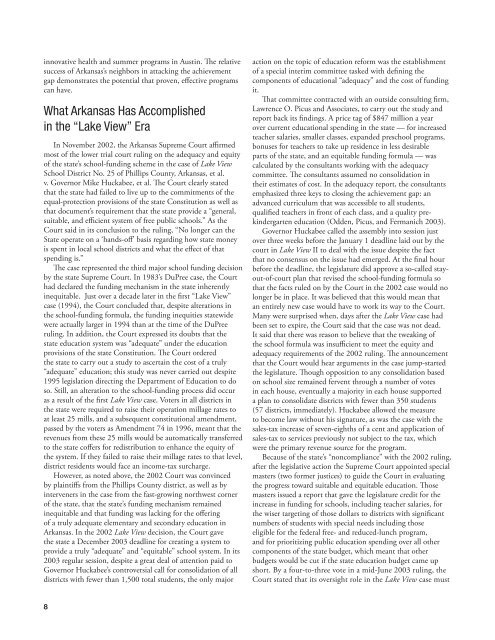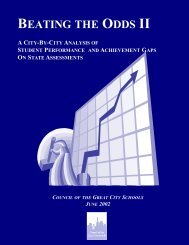WHAT IS ARKANSAS DOING TO CLOSE THE ACHIEVEMENT GAP?
WHAT IS ARKANSAS DOING TO CLOSE THE ACHIEVEMENT GAP?
WHAT IS ARKANSAS DOING TO CLOSE THE ACHIEVEMENT GAP?
You also want an ePaper? Increase the reach of your titles
YUMPU automatically turns print PDFs into web optimized ePapers that Google loves.
innovative health and summer programs in Austin. The relative<br />
success of Arkansas’s neighbors in attacking the achievement<br />
gap demonstrates the potential that proven, effective programs<br />
can have.<br />
What Arkansas Has Accomplished<br />
in the “Lake View” Era<br />
In November 2002, the Arkansas Supreme Court affirmed<br />
most of the lower trial court ruling on the adequacy and equity<br />
of the state’s school-funding scheme in the case of Lake View<br />
School District No. 25 of Phillips County, Arkansas, et al.<br />
v. Governor Mike Huckabee, et al. The Court clearly stated<br />
that the state had failed to live up to the commitments of the<br />
equal-protection provisions of the state Constitution as well as<br />
that document’s requirement that the state provide a “general,<br />
suitable, and efficient system of free public schools.” As the<br />
Court said in its conclusion to the ruling, “No longer can the<br />
State operate on a ‘hands-off’ basis regarding how state money<br />
is spent in local school districts and what the effect of that<br />
spending is.”<br />
The case represented the third major school funding decision<br />
by the state Supreme Court. In 1983’s DuPree case, the Court<br />
had declared the funding mechanism in the state inherently<br />
inequitable. Just over a decade later in the first “Lake View”<br />
case (1994), the Court concluded that, despite alterations in<br />
the school-funding formula, the funding inequities statewide<br />
were actually larger in 1994 than at the time of the DuPree<br />
ruling. In addition, the Court expressed its doubts that the<br />
state education system was “adequate” under the education<br />
provisions of the state Constitution. The Court ordered<br />
the state to carry out a study to ascertain the cost of a truly<br />
“adequate” education; this study was never carried out despite<br />
1995 legislation directing the Department of Education to do<br />
so. Still, an alteration to the school-funding process did occur<br />
as a result of the first Lake View case. Voters in all districts in<br />
the state were required to raise their operation millage rates to<br />
at least 25 mills, and a subsequent constitutional amendment,<br />
passed by the voters as Amendment 74 in 1996, meant that the<br />
revenues from these 25 mills would be automatically transferred<br />
to the state coffers for redistribution to enhance the equity of<br />
the system. If they failed to raise their millage rates to that level,<br />
district residents would face an income-tax surcharge.<br />
However, as noted above, the 2002 Court was convinced<br />
by plaintiffs from the Phillips County district, as well as by<br />
interveners in the case from the fast-growing northwest corner<br />
of the state, that the state’s funding mechanism remained<br />
inequitable and that funding was lacking for the offering<br />
of a truly adequate elementary and secondary education in<br />
Arkansas. In the 2002 Lake View decision, the Court gave<br />
the state a December 2003 deadline for creating a system to<br />
provide a truly “adequate” and “equitable” school system. In its<br />
2003 regular session, despite a great deal of attention paid to<br />
Governor Huckabee’s controversial call for consolidation of all<br />
districts with fewer than 1,500 total students, the only major<br />
action on the topic of education reform was the establishment<br />
of a special interim committee tasked with defining the<br />
components of educational “adequacy” and the cost of funding<br />
it.<br />
That committee contracted with an outside consulting firm,<br />
Lawrence O. Picus and Associates, to carry out the study and<br />
report back its findings. A price tag of $847 million a year<br />
over current educational spending in the state — for increased<br />
teacher salaries, smaller classes, expanded preschool programs,<br />
bonuses for teachers to take up residence in less desirable<br />
parts of the state, and an equitable funding formula — was<br />
calculated by the consultants working with the adequacy<br />
committee. The consultants assumed no consolidation in<br />
their estimates of cost. In the adequacy report, the consultants<br />
emphasized three keys to closing the achievement gap: an<br />
advanced curriculum that was accessible to all students,<br />
qualified teachers in front of each class, and a quality prekindergarten<br />
education (Odden, Picus, and Fermanich 2003).<br />
Governor Huckabee called the assembly into session just<br />
over three weeks before the January 1 deadline laid out by the<br />
court in Lake View II to deal with the issue despite the fact<br />
that no consensus on the issue had emerged. At the final hour<br />
before the deadline, the legislature did approve a so-called stayout-of-court<br />
plan that revised the school-funding formula so<br />
that the facts ruled on by the Court in the 2002 case would no<br />
longer be in place. It was believed that this would mean that<br />
an entirely new case would have to work its way to the Court.<br />
Many were surprised when, days after the Lake View case had<br />
been set to expire, the Court said that the case was not dead.<br />
It said that there was reason to believe that the tweaking of<br />
the school formula was insufficient to meet the equity and<br />
adequacy requirements of the 2002 ruling. The announcement<br />
that the Court would hear arguments in the case jump-started<br />
the legislature. Though opposition to any consolidation based<br />
on school size remained fervent through a number of votes<br />
in each house, eventually a majority in each house supported<br />
a plan to consolidate districts with fewer than 350 students<br />
(57 districts, immediately). Huckabee allowed the measure<br />
to become law without his signature, as was the case with the<br />
sales-tax increase of seven-eighths of a cent and application of<br />
sales-tax to services previously not subject to the tax, which<br />
were the primary revenue source for the program.<br />
Because of the state’s “noncompliance” with the 2002 ruling,<br />
after the legislative action the Supreme Court appointed special<br />
masters (two former justices) to guide the Court in evaluating<br />
the progress toward suitable and equitable education. Those<br />
masters issued a report that gave the legislature credit for the<br />
increase in funding for schools, including teacher salaries, for<br />
the wiser targeting of those dollars to districts with significant<br />
numbers of students with special needs including those<br />
eligible for the federal free- and reduced-lunch program,<br />
and for prioritizing public education spending over all other<br />
components of the state budget, which meant that other<br />
budgets would be cut if the state education budget came up<br />
short. By a four-to-three vote in a mid-June 2003 ruling, the<br />
Court stated that its oversight role in the Lake View case must<br />
8






